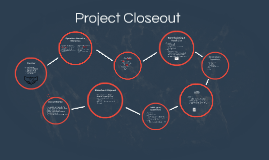Project Closeout & Termination
Transcript: Final Project Report requirements Project - xxx Vision statement Mission statement - key market, contribution. TOWS matrix Project selection methods - checklists, comparisons, reasons. Scope Project team & tasks - report on process, conflicts, fallback, problem & resolve. Cost - survey, estimate, marketing. Schedule - planing, flows, networks. Project constrain - source & solution. Timeline & Loading table Project Evaluation Closeout summary Project termination consists of all activities consistent with closing out the project. It is a process that provides for acceptance of the project by the project's sponsor, completion of various project records, final revision and issue of documentation to reflect its condition, and retention of essential project documentation. There are 4 types of project termination; 1.Termination by extinction. 2.Termination by addition. 3.Termination by integration. 4. Termination by starvation. The conclusion of a project involves these paperworks; Gaining Acceptance for the project - "Client acceptance" represents the recognition that simply transfering the project to customer is not sufficient to ensure the customer's happiness with it, use of it, and recognition of its benefits. The product finally may or mau not be what customer actually desired. Objectivity - Refer to the need for an unbased, critical review of the project from the prospective of someone without an agenda. Internal Consistency - A logical & well constructed procedure must be established and followed when conducting review. Standardization is key to internally consistent evaluations. Replicability - A standardized review process should yield similar finding regardless of who conducts the evaluation. Fairness - Member of the team must preceive that the review was conducted fairly, without agenda, and intended to hightlight both successes and failures. Harvesting the Benefits - The benefits behind the completion of a project should be easy to determine, in fact, we could argue that projects are created for the purpose of attaining some benefit to their parent organizations. As a result, the idea of harvesting these benefits suggest that we be in a position to assess the value the project adds, either to an external customer or to our own organization, or both. 1. Documentation = All pertinent records of the project; schedule & planning documents, monitoring & control materials, resource usage, specification...etc 2. Legal = All contractual documents; terms & conditions, legal resource, penalties, incentive, and other legal records. 3. Cost = Accounting records, list of material or other resource used, major purchases, or other budgetary items. 4. Personnel = The cost and other charges for all project team personnel must be accounted for, their time charged against project accounts, and any company overhead in the form of benefits identified. Handing over the project - This process involve a formal transfer of ownership of the project to the customer, including any terms and conditions for the transfer. Depending on the complexity of the transfer process, the handing-over steps can require meticulous planning in their own right. Reviewing How it all went - Some basic principles must be followed when evaluating a project's (and project's team) performance. 12:00 The elements of the final project report inlude an evaluation of a number of project and organization factors, including: Tuesday, April 25, 2017 The closeout Process Putting it all to bed Final stage of Projects Preparing the Final Project Report The process of closeout is complex, involoving multiple activities that must occur across a defined period. Deadline Fininshing the work - As a is almost complete, identifying a "Punch list" of final tasks or modifications that are needed prior to project completion. Checklist and other simple control devices provide an important element of structure to final tasks, reminding the project team that althougth the majority of the work has been finished, the project is not yet done. Modifications or adjustments may be necessary before the project will be acceptable to the client. Project Closeout & Termination 1. Project Performance. The project performance should involve a candid assessment of the project's achievements relative to its plan. 2. Administrative Performance. The evaluation of any standard administrative practices that occur within the organization, and their benefits or drawbacks in developing the just-completed project. 3. Organizational Structure. How the organizational's operating structure either helped or hindered the project team and their efforts. 4. Team performance. The effectiveness of the project team, not only in terms of their actual performance on the project, but also with regard to team-building and staffing policies, training , and performance evaluations for all team members. 5. Techniques of Project Management. The methods use by the organization for estimating activity duration and

















